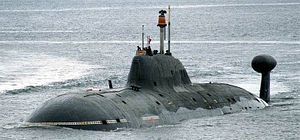NATO’s top naval officer said that Russia has been deploying its submarine force at levels unseen since the end of the Cold War in the Atlantic Ocean and that Moscow’s undersea fleet has made a major jump in its technological capabilities, IHS Jane’s Defense Weekly reports.
According to Vice Admiral Clive Johnstone, Commander of NATO’s Maritime Command, Western sub commanders are reporting “more activity from Russian submarines than we’ve seen since the days of the Cold War”. This is “”very different from the period of quiet submarine activity that perhaps we’ve seen in the past,” he adds.
Simultaneously, the technical capabilities displayed by Russian submarines have increased. It is “a level of Russian capability that we haven’t seen before,” the admiral says. The Russian Navy accomplished this “through an extraordinary investment path not mirrored by the West” and has made “technology leaps that [are] remarkable, and credit to them.”
Russian submarines currently patrolling the oceans “have longer ranges, they have better systems, they’re freer to operate”, he underlined. In addition, NATO has “seen a rise in professionalism and ability to operate their boats that we haven’t seen before,” explained the admiral.
Russia has been engaged in an ambitious naval rearmament program over the last couple of years, with repeated announcements of new submarine types under development.The Russian Navy’s Deputy Commander-in-Chief for Armament Viktor Bursuk recently boasted that “each of the prospective submarine projects to be built will embody all the best features of its predecessors,” Sputnik News reports. Nevertheless, Moscow has been struggling with certain submarine technologies such as air-independent propulsion systems (AIP), which time and again has caused delays in the construction of new vessels.
Russia has also stepped up its patrolling activity in the Pacific over the last year. “Russia in the last few months has returned to, I would say, nearly a Cold War level of activity that goes towards our homeland, with long-range attacks, exercises and those types of things,” the then commander of U.S. Pacific Command, Admiral Samuel Locklear, told the U.S. House of Representatives Armed Services Committee in April 2015. “We also know that Russia will improve their strategic nuclear deterrent on what’s thought as their east coast, which is in the Northern Pacific,” he said. Moscow is “reasserting itself” politically and militarily in the region, according to the admiral.
As I report in this month’s The Diplomat Magazine, Russia’s Pacific Fleet has for the first time since the end of the Soviet Union received a new nuclear-powered ballistic missile submarine (SSBN), with another SSBN slated to join the fleet in 2016. In addition, the Russian Navy recently announced that it will build six Improved Kilo-class submarines for the Pacific Fleet, indicating the growing strategic importance of the region for Russia.
According to IHS Jane’s Defense Weekly, Vice Admiral Clive Johnstone expressed genuine concern over the Russian Navy’s increased pace of submarine patrols. “I think none of that would worry us if we knew what the game plans were or we knew why they were deploying or what they were doing … we don’t understand what the strategic and operational objectives are of the Russian state.” He also admitted that “a lot of what the Russians are doing at the moment we don’t understand, and is obscure and is shrouded in other activity which makes us nervous, and makes nations nervous.”

































